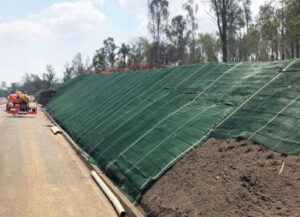Geotextile fabric is a type of synthetic textile material specifically designed for use in civil engineering and geotechnical applications. It is commonly used to enhance the performance and durability of soil in various construction projects. Geotextiles are typically made from synthetic polymers such as polypropylene or polyester, although natural fibers like jute or coir can also be used.
Geotextile fabric is characterized by its permeability, strength, and resistance to biological degradation, chemicals, and ultraviolet (UV) radiation. It is available in different forms, including woven and non-woven varieties. Woven geotextiles are made by interlacing the yarns in a crisscross pattern, resulting in a strong and stable fabric. Non-woven geotextiles, on the other hand, are manufactured by mechanically bonding or needle-punching synthetic fibers together.
The primary purpose of geotextile fabric is to provide separation, filtration, reinforcement, and drainage functions in geotechnical engineering projects. Here are some common applications of geotextiles:
1. Separation: Geotextiles are used to separate different types of soils or aggregates with varying particle sizes. They prevent the mixing of materials, such as preventing fine soil particles from clogging drainage systems while allowing water to pass through.
2. Filtration: Geotextiles act as filters by allowing water to pass through while retaining soil particles. They are used to prevent soil erosion by stabilizing embankments and slopes, while still allowing water to drain away.
3. Reinforcement: Geotextiles can enhance the strength and stability of soil structures. They are used in road and railway construction to reinforce the ground and distribute loads more evenly, reducing settlement and improving overall performance.
4. Drainage: Geotextiles provide a pathway for water to flow through the soil, facilitating effective drainage. They are used in applications such as retaining walls, landfills, and drainage systems to prevent water accumulation and improve overall stability.
Overall, geotextile fabric plays a vital role in various civil engineering projects by providing durability, increased load-bearing capacity, and improved performance to the soil or aggregate it is applied to.




